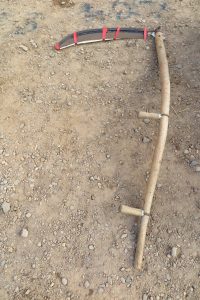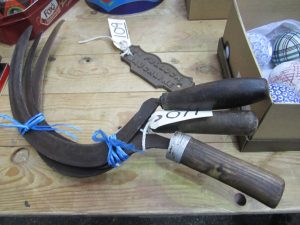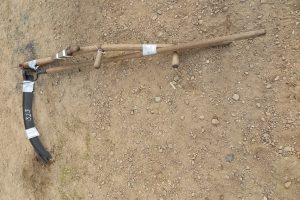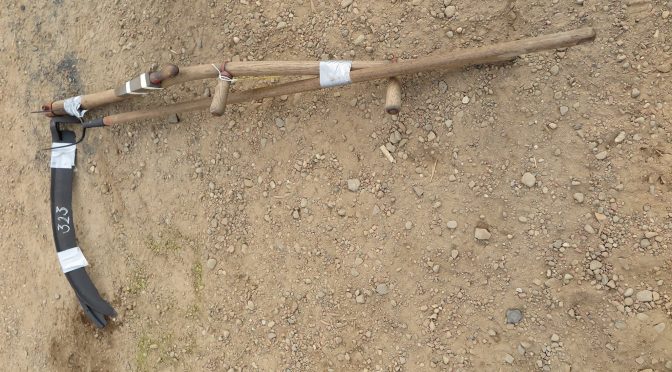The county agricultural surveys include a number of detailed account of harvesting and harvesting tools and implements. Robert Somerville, the surveyor of East Lothian provides an interesting account in his survey. What a contrast to today’s grain harvest!
“The implements commonly used for cutting down and gathering the crop, are the scythe, the rake, and the reaping hook. The first of these, the scythe, is less employed than might be expected in a county where so much grain is raised; upon the best lands, indeed, especially in wet seasons when the crop is lodged, the use of the  scythe is inadmissible, but in ordinary years, a great part of the crop admits of being cut down with that implement, as much less ceps than by the hand, with the additional advantage of its affording from a third to a fourth more fodder, than what is obtained, under common management, where the crop is cut by the hand, an object of no small importance in any situation, but especially in places, where, owing to the distance from great towns, there is no opportunity of purchasing manure. It is objected to the scythe, that it does not lay the heads so regular, as when the crop is cut by the hand; this certainly is the fact, and unquestionably is a disadvantage, especially where thrashing machines are used; it is also said, that, in cases where the crib is thin, and at the same time completely ripened, if the stalk has acquired a degree of hardness sufficient to bear the stroke of the scythe, the shock will be so great as to shake out many of the grain; or, if the straw is of a soft texture, in place of being cut and gathered by the scythe, the crop will be beat down, and a great part of it left uncut. These objections, however, apply only to cases where it has been allowed to stand too long, as in every instance, where it is cut at the proper period, it is found to bear the stroke of the scythe, without either shaking out the grains of breaking down the stalks.
scythe is inadmissible, but in ordinary years, a great part of the crop admits of being cut down with that implement, as much less ceps than by the hand, with the additional advantage of its affording from a third to a fourth more fodder, than what is obtained, under common management, where the crop is cut by the hand, an object of no small importance in any situation, but especially in places, where, owing to the distance from great towns, there is no opportunity of purchasing manure. It is objected to the scythe, that it does not lay the heads so regular, as when the crop is cut by the hand; this certainly is the fact, and unquestionably is a disadvantage, especially where thrashing machines are used; it is also said, that, in cases where the crib is thin, and at the same time completely ripened, if the stalk has acquired a degree of hardness sufficient to bear the stroke of the scythe, the shock will be so great as to shake out many of the grain; or, if the straw is of a soft texture, in place of being cut and gathered by the scythe, the crop will be beat down, and a great part of it left uncut. These objections, however, apply only to cases where it has been allowed to stand too long, as in every instance, where it is cut at the proper period, it is found to bear the stroke of the scythe, without either shaking out the grains of breaking down the stalks.
 Sickle-Formerly two kind were used, the broad and narrow; the former is now entirely laid aside, and the latter substituted in its place. As the sickle is an instrument in use everywhere, and as the one used in this county possesses no peculiarity, any particular description is unnecessary.
Sickle-Formerly two kind were used, the broad and narrow; the former is now entirely laid aside, and the latter substituted in its place. As the sickle is an instrument in use everywhere, and as the one used in this county possesses no peculiarity, any particular description is unnecessary.
Rake-When the crop is cut by the scythe, the common hay rake is generally employed, and, in expert hands, answers the purpose extremely well; the same implement is sometimes used when the crop is cut by the hand, a person following the cart, and gathering what is left on the places where the stokes have stood. A different kind of rake has been partially tried, and found to answer the purpose, much better than the hayrack. The length of the head is from ten to fifteen feet, the handle about seven feet, with a piece of wood across the end of it, by which it is drawn by two men; the teeth are of wood or iron, the last are the best, as well as the most durable, and are a little bent forward at the point, which gives them the power of retaining and carrying the ears along with them, much better than they would otherwise do. To make clean work, especially  if the ridges are gathered, the field is raked across; in that way, every thing is taken up; but, when it is preferred to draw the rake in the directions of the ridge in the direction of the ridges, it may be considerably improved, by cutting the head into two or three lengths, and joining them with hinges, which will allow it to bend and accommodate itself to the curvature of the ridges. The advantage of this kind of rake has been found considerable, even in cases where every possible attention has been paid to the cutting of the crop; but, as it frequently happens, that owing to dampness, greens of the straw, or a foul grassy bottom, it is necessary to leave the crop unbound for a day or two, during which, if it is overtaken by a high wind, much of it will be scattered and lost, unless considerable pains are taken to gather it, by hand-raking and otherwise-Where the long rake is used for that purpose, the expense will in no instance exceed 4d sterling per acre. And experiment, made upon a field of 30 acres, will convey some idea of the benefit that may be derived from the use of that instrument. The field was in barley, and the rankings, when thrashed yielded £14 5s 0d.
if the ridges are gathered, the field is raked across; in that way, every thing is taken up; but, when it is preferred to draw the rake in the directions of the ridge in the direction of the ridges, it may be considerably improved, by cutting the head into two or three lengths, and joining them with hinges, which will allow it to bend and accommodate itself to the curvature of the ridges. The advantage of this kind of rake has been found considerable, even in cases where every possible attention has been paid to the cutting of the crop; but, as it frequently happens, that owing to dampness, greens of the straw, or a foul grassy bottom, it is necessary to leave the crop unbound for a day or two, during which, if it is overtaken by a high wind, much of it will be scattered and lost, unless considerable pains are taken to gather it, by hand-raking and otherwise-Where the long rake is used for that purpose, the expense will in no instance exceed 4d sterling per acre. And experiment, made upon a field of 30 acres, will convey some idea of the benefit that may be derived from the use of that instrument. The field was in barley, and the rankings, when thrashed yielded £14 5s 0d.
Carrying the crop-many years ago, the crop was brought home on sledges, afterwards on close carts with a frame on the top; at present, hay and the different kinds of grain are carried upon the open spoked cart, known by the name of corn-cart, which, from its lightness and construction, seems better adapted to the purpose, than any thing of the kind hitherto emploed. These carts appear capable of some improvement, by lining their sides and bottom either with thin planks or canvass, the expense of which would be very inconsiderable, and the whole of the grain, beat out in the operations of uploading, unloading, and the carriage from the field, saved.”
The photographs of the scythes and binder canvasses were taken at the National Tractor Show, Lanark, September, 2015.
